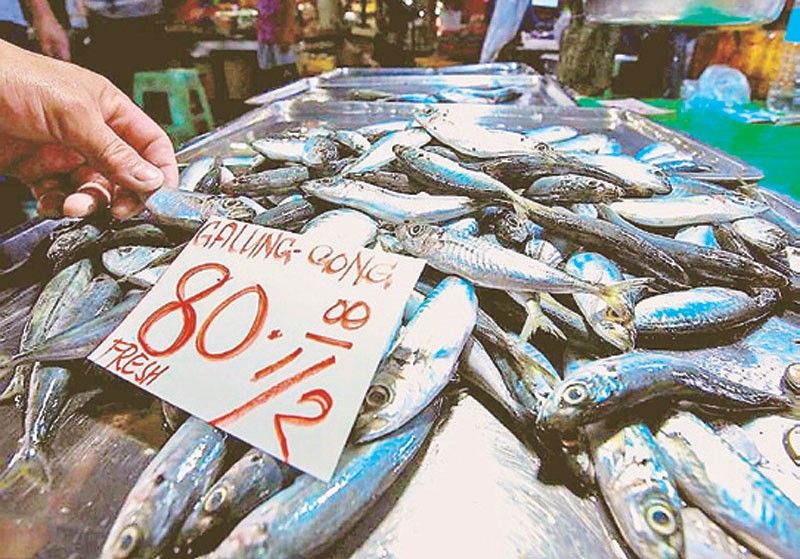Fisherfolk warn of fake sardine shortage

MANILA, Philippines — Fisherfolk group Pambansang Lakas ng Kilusang Mamamalakaya ng Pilipinas (Pamalakaya) has warned the government about a shortage of tamban or Indian sardines that is allegedly being “fabricated” by big fishing firms and canneries.
In a press statement yesterday, Pamalakaya said the supposed low supply and output of tamban was just being made up by fishing firms and operators supposedly to increase the retail prices of canned sardines and to push for their vessels’ entry into municipal waters.
“The BFAR (Bureau of Fisheries and Aquatic Resources) should remain vigilant against this fabricated tamban shortage that will only favor big fishing firms and operators over the interests of small fishers and consumers,” Pamalakaya national chairman Fernando Hicap said.
Hicap pointed out that the BFAR had earlier reported a 222.58 percent sufficiency level of tamban during the first quarter of this year, thus the supposed supply shortage was unlikely.
Pamalakaya asserted that commercial fishing vessels, those weighing 3.1 gross tons and above, should be restricted within the 15-kilometer municipal fishing grounds from the coastline.
“The municipal waters should remain as it is – exclusive to small fisherfolk. Operators of commercial fishing vessels should not take advantage of this alleged tamban shortage to push their entry in the municipal fishing zone,” Hicap said.
“Big fishing vessels remain to be one of the major threats to small fishers because their large-scale and even destructive operations exhaust and exploit the fishery and marine resources,” he added.
Pamalakaya lamented that while the existing fisheries law declared municipal waters for small fishers, commercial fishing vessels are still able to enter in some areas “because they are either owned by or conniving with local government units (LGUs).”
Additionally, the amended Philippine Fisheries Code states that commercial vessels can enter any body of water with a depth reaching seven fathoms and above, regardless if it covers municipal waters, according to the group.
“This is how big fishing operators manipulate the existing fisheries law. Allowing these large fishing vessels to enter municipal waters would result in steep decline in the catch of our small fisherfolk, which would lead to low supply and higher prices in the market,” Hicap said in English and Filipino.
Enough supply
Despite warnings of shortage, the country has sufficient supply of sardines for the rest of the year, according to the Department of Agriculture (DA).
The DA said the BFAR has forecasted annual sardine (tamban) production to reach 293,431 metric tons, covering the national demand of 101,367 MT.
The volume, which is entirely sourced locally, comes from commercial and municipal fishers, at 208,387 MT and 85,043 MT, respectively.
The DA also cited data from the Philippine Statistics Authority (PSA) and the BFAR showing that the sufficiency level for sardines is pegged at 222.58 percent for the first quarter and 409.06 percent for the second quarter.
Data from the National Stock Assessment Program of the National Fisheries Research and Development Institute also showed that sardine stock has significantly improved, resulting in more sardines reaching maturity and appropriate catchable size.
The DA attributed the stable sardine supply to the effective implementation of the National Sardine Management Plan (NSMP), a five-year plan which harmonizes all the policies and programs on sardines, including conservation measures such as the closed fishing seasons.
Since the NSMP’s implementation in 2020, a notable improvement in production and supply has been recorded, according to the DA.
In a radio interview, DA Senior Undersecretary Domingo Panganiban said the agency would consider discussions with Canned Sardines Association of the Philippines to discuss the alleged tamban shortage.
“We shall do that. In the meantime, we are still reviewing the sardines industry, the materials used in the canning of sardines because the tin can is the most expensive input, not the sardines itself,” Panganiban said in Filipino.
As to CSAP’s request to open up municipal waters to commercial fishing vessels to address the alleged looming sardines shortage, the BFAR said it would only allow what is stated under Republic Act 10654 or the amended Philippine Fisheries Code.
The law states that small and medium commercial fishing vessels may be allowed to operate within the 10.1 to 15 kilometers from the shoreline in municipal waters provided that the LGU enacts a municipal ordinance allowing their operation.
In a radio interview, Philippine Association of Fish Producers Inc. chairman David Villaluz, who also sits in the National Fisheries and Aquatic Resources Management Council, said there is currently a tug-of-war between commercial and municipal fishermen.
The CSAP said sardines are abundant in municipal waters where they cannot operate.
Not enough
While the government has stressed that there is sufficient supply of sardines in the country, the CSAP remained firm that there are not enough sardines in commercial waters for manufacturing firms.
“Maybe, there is plenty of sardines in municipal waters for the wet market. There is not enough in commercial waters for canneries. Our catch data does not align with BFAR reports,” CSAP executive director Francisco Buencamino told The STAR in a text message.
In an interview with Net25 yesterday, Buencamino suggested that the three-month closed fishing season be moved instead to another time in the year from the original schedule of December to February.
He explained that the current lack of sardines in commercial waters is due to the natural tendency of the fish to move toward the shore, where planktons they feed on are found, at this time of the year.
In the same interview, Buencamino affirmed that the packaging costs of canned sardines have increased due to the higher prices of steel plate.
The Department Trade and Industry (DTI) earlier reported that the suggested retail price of canned sardines in tomato sauce increased by six percent in its latest bulletin released Aug. 12.
Buencamino declined to comment on whether canned sardine manufacturers will file a petition for a price increase with the DTI amid the supply issues. – Danessa Rivera, Catherine Talavera
- Latest
- Trending































